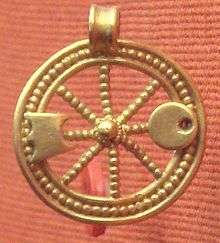Naria

Naria was a goddess in Gallo-Roman religion who appears to have been venerated only in what is now the western part of Switzerland. Her nature and responsibilities remain obscure.[1]
She is mentioned only twice in known inscriptions from the Gallo-Roman era. One, on a stone altar from Cressier, reads Nariae Novsantiae T. Frontin. Hibernvs V.S.L.M,[2] that is: "To Naria Nousantia, Titus Frontinius Hibernus willingly and deservedly fulfilled his vow". The epithet 'Nousantia' is otherwise unknown.[3] The other inscription is on the base of a statuette from the Muri statuette group. That inscription, Deae Nariae Reg(io) Arvre(nsis) Cvr(ante) Feroc(e) L(iberto),[4] translates as: "The Aar area association dedicated this to the goddess Naria; the freedman Ferox served as curator."
The Muri statuette is also the only known depiction of Naria. It shows her in a long sleeved dress and with a diadem in her hair. The hands which held her divine attributes are missing. This depiction of Naria follows a generic style then used in Italy mostly for depictions of the goddess of luck, Fortuna. This indicates that Naria might also have been conceived of as a goddess of good luck and blessings.[1]
References
- 1 2 Kaufmann-Heinimann, Annemarie (2002). Dea Artio, die Bärengöttin von Muri: römische Bronzestatuetten aus einem ländlichen Heiligtum. Glanzlichter aus dem Bernischen Historischen Museum (in German). 9. Zürich: Chronos Verlag. pp. 44–46. ISBN 3-0340-0544-X.
- ↑ CIL XIII: 5151.
- ↑ Guillaume Roussel. "Nousantia - 6981". L'Arbre celtique (in French). Retrieved 2010-10-29.
- ↑ CIL XIII: 5161.

